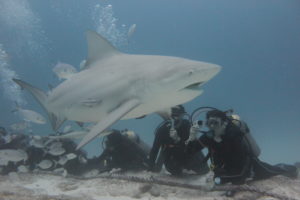Leadership Secrets from Under the Sea
Written by Mike Oechsner

I first got exposed to scuba diving when I was 13 years old – at the Boy Scouts of America Jamboree 93. It may not really count because it was in a 4-feet deep pool. But it was a cool experience! When I was 18 and on my graduation trip with my grandparents – I got to do the real thing in Hawaii – and knew I was hooked! It wasn’t until over 15 years later that I actually went for my certification – and now I am a certified Open Water Diver, Nitrox Enriched Air certified diver, and Advanced certified diver.
Everyone is probably now wondering what in the world Scuba Diving and Leadership have to do with each other? You’d be a little surprised – they have a LOT to do with each other.
Just some of the Leadership Skills that get tested and used in diving include:
- Non Verbal Communication
- Preparation & Planning
- Math
- Adversity
Communication
When you are as much as 120 feet under the surface, somehow you have to be able to communicate with your dive buddy and anyone else you may be diving with. Diving communication is a universal language that works anywhere in the world – but – it’s always great to visit with everyone you’re going on a dive with before diving to make sure that nobody has their own special dialects.
Fun fact – giving someone a thumbs up does NOT mean “I’m having a great time – this is fun!” It actually means that, for some reason or another, I need to go up to the surface. To tell someone that you’re having a good time, it’s actually the “okay” symbol with your fingers. You also need to be able to communicate with your fellow divers about how much air you have left, how much time you have left at a depth, you need to be able to alert them to potential danger, and you may want to be able to point out something super cool (like a 9 foot turtle….well, hopefully they wouldn’t miss that).
Preparation and Planning
When going on a dive, there always has to be a plan. The moment you go under the water, you have a limited amount of air available to you. Depending on how deep the dive is, you also have a limited amount of time before you must come back to the surface. You have to plan your dive – depth, time, distance, and more. If you’re visiting a new dive site, there are ways to research the currents, depth, and more – or you can always choose to take a guided trip.

Math
I know – I’m old – because in my three years of high school accounting, I was classically trained with paper and pencil – double entry journal, general ledger accounts, and fully manual bookkeeping. Even nearly 25 years ago when I was learning – nobody kept books this way any longer. QuickBooks was a thing even way back then. But, by understanding how everything works in the background, I have a much more full concept of everything that accounting entails.
Much like accounting, I was classically trained in reading and understanding dive tables. The dive tables are some serious math where you calculate your dive depth, your dive time, how much time you must have on the surface before diving again, and how much impact all of the above will have on the length and depth of the next dive. I don’t think I’ve seen a single diver using dive tables in the last 5 years – everyone dives with a computer, and they are just a standard piece of equipment if you go on a guided dive, and most of us have our own. Just like accounting, I’m very excited that I learned the old way so that I can clearly understand the entire concept of diving safely.
Adversity
In my open water certification, part of the test dive was to have the instructor turn off my air at 15 feet of depth and for me to demonstrate that I could safely make it to the surface. Big deal? Didn’t feel like it at first – I have gone to the bottom of 14 foot pools since I was a kid. But, when you’ve been diving at 30, 45, 60, or more feet in depth – you cannot go up quickly, you have to carefully and slowly ascend to avoid compression sickness. Practicing this is important – but hopefully a skill that you never have to use in real life. Because of how air expands and contracts – you do, as a diver, have enough air to ascend from as much as 40 feet or more safely if you control your oxygen correctly. It’s a new experience! For advanced certification, I had to ascend from 30 feet without oxygen.
So many cool things!
Over the years, I’ve been able to experience multiple shark dives, I’ve held a squid, I’ve written on sea slugs, I’ve seen manta rays larger than me – but most importantly, I’ve been able to introduce at least ten of my friends into the excitement of scuba diving on different trips – and I’m always happy to introduce anyone else!


